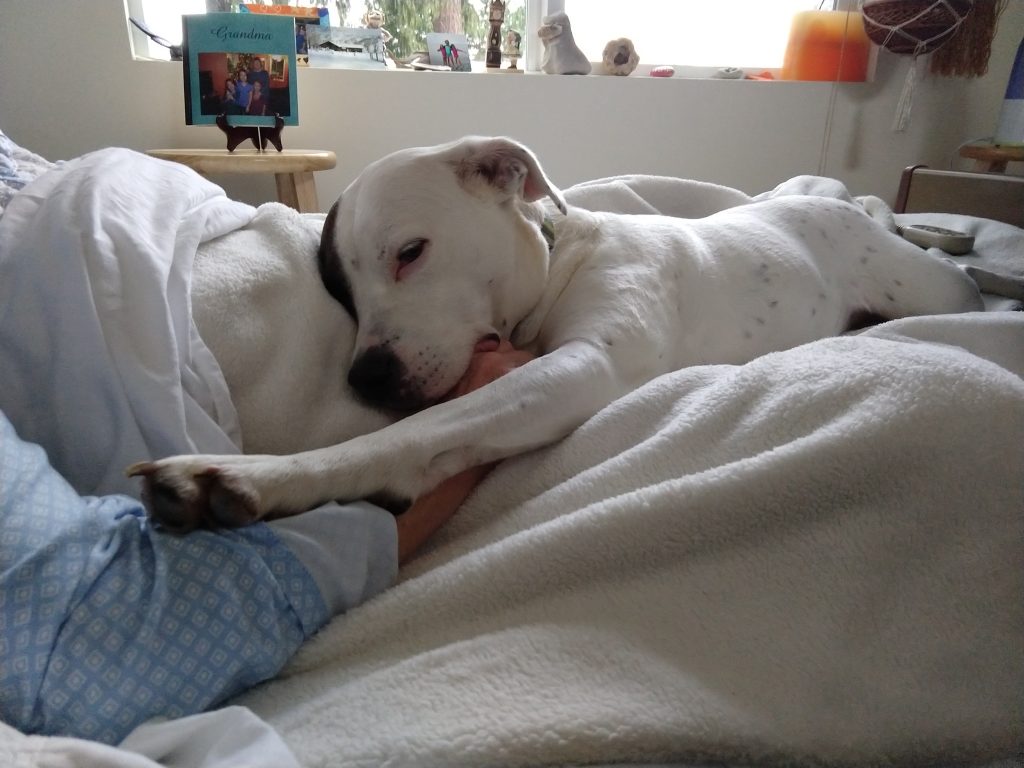s
How a death doula assists with VSED
s
What is a death doula?
A Death Doula, sometimes called an end-of-life guide or death midwife, is a non-medical person who serves the dying person and their family. Her work is part case-manager and part godmother, as she maintains a holistic perspective of the mental, physical, and spiritual needs of the client and family. Her tasks include educating the client and family members about the VSED process, helping them navigate conversations with their health care provider, and assisting them in gathering a supportive group of caregivers. Her ability to coordinate with physicians, hospice staff, visitors, pharmacists, and caregivers gives family members the chance to support their loved one and take good care of themselves during this time of transition.
A death doula collaborates with hospice staff—if hospice is involved—by supporting family members and caregivers in following hospice directives. Unlike hospice staff, who have a caseload of clients to visit, a death doula has only one client. While a hospice nurse has specific time constraints and focuses on the immediate medical needs of the patient, the doula is available 24/7 to respond to family dynamics, anticipate needs for information and support, manage guest visits, and guide the family through each step of the dying process. And because the death doula has the time and intention to be with and know the family well, her insights can be useful to hospice staff.
It is a sacred and intense calling for the death doula to be consistently present as the VSED client completes their life’s work—saying “I love you,” asking for and receiving forgiveness, and saying goodbye.

Death Doula Responsibilities in Preparation for VSED
Prepare client and family
Speak initially with client or his/her representative
- Determine how best to consistently reach him/her (phone, email, message)
- Describe role of Death Doula (what it is and what it is not)
- Discern what the client & family want and need
- Determine if this will be a good fit for all concerned
- Offer contract and individualize it as needed
Meet with client and point person to begin discussing VSED process
- Meet with other family members to answer questions, share concerns
- Who are the medical professionals involved with this family?
- Has client spoken with PCP re desire to do VSED?
- Who will be the family’s point person for client?
- Send VSED resources to client & family and review them in person; assess understanding
- Offer names and phone numbers of other families who have witnessed VSED
Talk about selection of a start date for VSED and what needs to be in place beforehand
- Determine what medications are currently being taken
- Ask about significant medical history, including mental health, trauma
- Ask about normal daily routine: waking, toileting, meals, quiet time, social time, bedtime
- Review with client (and family) the responses to “List of things that comfort me,” discuss significance
Determine what preparation has been done in advance
- Determine status of Advance Care Plan and POLST
- Determine who is Durable Power of Attorney (DPOA) for Healthcare
- Determine status of legal preparation: DPOA for Finances, Release and Assumption of Risk document for caregivers and family members, Will
- Discuss usefulness of preparing two videos – one on phone for quick reference and a longer one on thumb drive for legal protection
- Assist in making videos if desired
Explain physical preparation for VSED–diminished calories, diminished intake, cleanse
- Explain medications that might be used: what they are, what they do
- Talk with family and client about level of sedation wanted/anticipated by physician, client, family
- Talk about fears (death, pain, suffering, separation, regrets, goodbyes, etc.) of both client and family that may influence this end-of-life experience
Discuss with client and family plans for disposition of the body
- Cremation, burial, or green burial?
- Assist family with completing paperwork in advance for disposition of the body
Offer an intention-setting ceremony before VSED begins
- Gather family, friends, and caregivers to offer support for what is about to happen
- Talk about significance of ceremonies or rituals
- Celebrate the person getting ready to embark on their VSED journey
Encourage client and family to document the VSED journey
- Talk about significance of photos
- Encourage family members to journal, draw, photograph during VSED days as important outlet
Help family anticipate preferences/needs for the immediate days after death
- Discuss self-care, comfort, sitting shiva, asking for help, asking for quiet
- Share ideas for distraction from grief

Request family complete intake with End of Life WA for data collection
Introduce idea of legacy work (if time permits or if family can be engaged in doing so)
Coordinate external agency support, supplies and equipment, and records
Coordinate with physician
- Have client sign communication release document for PH-associated providers
- Notify physician of Death Doula (DD) assistance with their client
- Give or email information about VSED
- What medications are currently being taken and when to stop them
- Request, if appropriate, liquid medication for pain, anxiety, and hallucinations as well as discussion of ways to do cleanse prior to start VSED
- Determine physician’s willingness to collaborate and communicate w/DD and family point person and family during process
- Determine physician’s willingness to make a home visit
- Communicate with physician during VSED process, as determined by earlier communication
- Communicate with physician after death, as determined by earlier communication
Coordinate with Hospice
- Discuss with family the importance/advantages of being on hospice
- Ask family to call Hospice and request an intake appointment
- Have client sign Communication Release Document for Peace Health (PH)
- Call/email hospice about DD involvement with participant’s VSED & request intake appointment for client
- Introduce self to each hospice staff person who comes to the home; offer card
- Thank hospice staff at every opportunity and after death for their collaboration and care
Oversee caregiving logistics
- Coordinate with Death Doula colleague(s) so there is 24/7 Death Doula coverage and accessibility
- Discuss with family the need for caregiving – safety, medication, comfort, continual assessment
- Determine need for non-family care-givers vs family involvement: how & when is family available
- Discuss with family the advantages/concerns of being the caregiver for their family member
- Hire caregivers so there is 24/7 coverage for client
- Introduce caregivers to client and family so compatibility is assured
- Review with caregivers, and teach/demonstrate if necessary, the expected skills for the VSED process
- Prepare schedule for 24/7 caregiving through 14 days
- Distribute copy of schedule to family and caregivers
Maintain records and paperwork in a notebook or binder
- Phone numbers for everyone involved
- Business cards and phone numbers for additional social resources
- Caregiver log sheet for each caregiver to track hours worked, date, time
- Medication sheet for meds given
- Progress notes for caregivers to document progress, family concerns and questions, hospice notes
- Email correspondence with client and family prior to start date
- Client’s most current Advance Care Plan with VSED addendum, if appropriate
- Hospice enrollment paperwork
- Signed Release & Assumption of Risk
- Copy of signed Death Doula contract
- Signed Communication Releases with Physicians and Hospice (Peace Health)
- VSED Resources NW documents for everyone to refer to
- Business receipts associated with this VSED process
Coordinate equipment and supplies
- Give family a list of recommended equipment, noting which ones can be borrowed from the group’s Lending Bank of Supplies
- Give family a list of necessary and helpful non-equipment supplies (lip balm, eye drops, lotion, incontinence supplies, etc.)
- Have equipment and supplies on hand by start date of VSED

Death Doula Responsibilities During and After VSED Process
During VSED
The death doula will be on-call 24/7 to family and caregivers. She sets the energy of love and compassion wherever client is located and makes a home visit each day to do the following:
- Offer anticipatory guidance to family about what the client is/will experience
- Offer anticipatory guidance to family about what changes they are/will see in client
- Assess how client is progressing in VSED process
- Observe how family members are adjusting, managing, maintaining self-care
- Assess how caregivers are working, adjusting, collaborating, maintaining self-care
- Determine how records are being maintained by caregivers
- Record any new change in medications, input from Hospice, use of resources
- Send updates to healthcare provider, if desired
- Invite family to look through notebook anytime and to add comments
- Strive to be present for visits from hospice staff, especially hospice RN visits
Following death
- Offer ceremony for last breath; washing body; leave-taking of the house
- Continue to help family assess their emotional and physical health
- Discuss realities of grieving
- Share grief resources that may be helpful
- Refer family members to area support groups and VSED Support Group
Final financial responsibilities
- Assess family’s ability to engage in business aspects of the death
- Prepare time-sheets based on caregiver log-in sheets
- Have stamped envelopes prepared so checks can be immediately mailed
- Mail checks or deliver to caregivers
Final evaluation responsibilities
- Assess family’s ability to engage in this final processing
- Review what happened and what was helpful
- Review what was challenging and how things could have been better
- How could the Death Doula been more attuned to the needs of client and family?
Follow-up with caregivers
- Discuss with caregivers (as a group) what went well and what was challenging
- Help each caregiver identify their individual strengths and what they’d like to learn and expand
- Ask for feedback r.e. DD role and responsibilities; did they feel supported?
- Have conversation about caregiver self-care and anticipatory grief